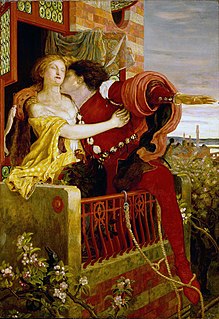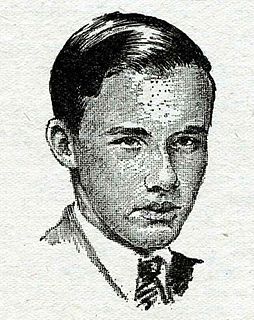
Unknown was an American pulp fantasy fiction magazine, published from 1939 to 1943 by Street & Smith, and edited by John W. Campbell. Unknown was a companion to Street & Smith's science fiction pulp, Astounding Science Fiction, which was also edited by Campbell at the time; many authors and illustrators contributed to both magazines. The leading fantasy magazine in the 1930s was Weird Tales, which focused on shock and horror. Campbell wanted to publish a fantasy magazine with more finesse and humor than Weird Tales, and put his plans into action when Eric Frank Russell sent him the manuscript of his novel Sinister Barrier, about aliens who own the human race. Unknown's first issue appeared in March 1939; in addition to Sinister Barrier, it included H. L. Gold's "Trouble With Water", a humorous fantasy about a New Yorker who meets a water gnome. Gold's story was the first of many in Unknown to combine commonplace reality with the fantastic.

Wall of Serpents is a collection of two fantasy short stories by American science fiction and fantasy authors L. Sprague de Camp and Fletcher Pratt, the third volume in their Harold Shea series. The pieces were originally published in the magazines Fantasy Fiction and Beyond Fantasy Fiction in the issues for June, 1953 and October, 1954. The collection was first published in hardcover by Avalon Books in 1960, with a new edition from Phantasia Press in 1978. The first paperback edition was published by Dell Books in 1979. A 1980 edition published by Sphere Books was retitled The Enchanter Compleated. An E-book edition was published by Gollancz's SF Gateway imprint on September 29, 2011 as part of a general release of de Camp's works in electronic form.

The Carnelian Cube is a fantasy novel by American writers L. Sprague de Camp and Fletcher Pratt. It was first published in hardcover by Gnome Press in 1948, and in paperback by Lancer Books in 1967. An E-book edition was published by Gollancz's SF Gateway imprint on September 29, 2011 as part of a general release of de Camp's works in electronic form. It has also been translated into Italian and German.

The Wheels of If and Other Science Fiction is a 1948 collection of science fiction stories by L. Sprague de Camp, first published in hardback by Shasta and in paperback by Berkley Books in 1970. It has also been translated into German. All the stories were originally published in the magazines Astounding Science Fiction and Unknown.

Sprague de Camp's New Anthology of Science Fiction is a collection of science fiction stories by American writer L. Sprague de Camp, edited by H. J. Campbell. It was first published in both hardcover and paperback in 1953 by Panther Books.

Tales from Gavagan's Bar is a collection of fantasy short stories by American writers L. Sprague de Camp and Fletcher Pratt, illustrated by the latter's wife Inga Pratt. It was first published in hardcover by Twayne Publishers in 1953; an expanded edition rearranging the contents and adding pieces not in the first was published in hardcover by Owlswick Press in June 1978. The original illustrations were retained in this edition. It was subsequently issued in paperback by Bantam Books in January 1980. An E-book edition was published by Gollancz's SF Gateway imprint on September 29, 2011 as part of a general release of de Camp's works in electronic form. The collection has also been published in German.

The Tritonian Ring and Other Pusadian Tales is a 1953 collection of stories by American science fiction and fantasy author L. Sprague de Camp, first published in hardcover by Twayne Publishers. An E-book edition was published as The Tritonian Ring and Other Pasudian [sic] Tales by Gollancz's SF Gateway imprint on September 29, 2011 as part of a general release of de Camp's works in electronic form. The pieces were originally published between 1951 and 1953 in the magazines and anthologies Two Complete Science Adventure Books, Fantasy Fiction, Imagination Stories of Science and Fantasy, and Fantastic Adventures. The title story, the novel The Tritonian Ring has also been published separately.

Divide and Rule is a 1948 collection of two science fiction novellas by American writer L. Sprague de Camp, first published in hardcover by Fantasy Press, and later reissued in paperback by Lancer Books in 1964. The collected pieces were previously published in 1939 and 1941 in the magazines Unknown and Astounding. The first stand-alone edition of the title story was published as a large-print hardcover by Thorndike Press in September 2003. An E-book edition of the title story was issued by Gollancz's SF Gateway imprint on September 29, 2011 as part of a general release of de Camp's works in electronic form.
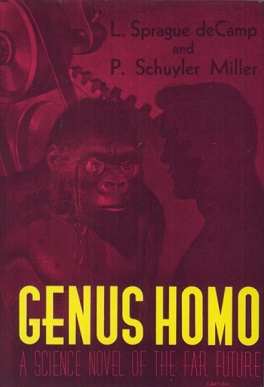
Genus Homo is a science fiction novel by American writers L. Sprague de Camp and P. Schuyler Miller. It was first published in the science fiction magazine Super Science Stories for March, 1941, and subsequently published in book form in hardcover by Fantasy Press in 1950 and in paperback by Berkley Books in 1961. An E-book edition was published by Gollancz's SF Gateway imprint on September 29, 2011 as part of a general release of de Camp's works in electronic form. It has also been translated into French, Italian and German.

Rogue Queen is a science fiction novel by American writer L. Sprague de Camp, the third book in his Viagens Interplanetarias series. It was first published in hardcover by Doubleday in 1951, and in paperback by Dell Books in 1952. A later hardcover edition was issued by The Easton Press in its The Masterpieces of Science Fiction series in 1996; later paperback editions were issued by Ace Books (1965) and Signet Books. A trade paperback edition was issued by Bluejay Books in June 1985. The first British edition was published in paperback by Pinnacle Books in 1954; a British hardcover reprint followed from Remploy in 1974. The novel has been translated into Portuguese, Italian, French and German. An E-book edition was published by Gollancz's SF Gateway imprint on September 29, 2011 as part of a general release of de Camp's works in electronic form. Arc Manor's Phoenix Pick imprint reissued the book in both trade paperback and e-book format in January 2012.
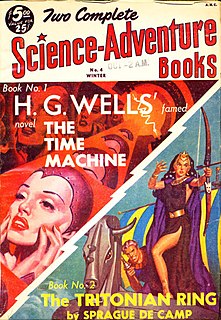
The Tritonian Ring is a fantasy novel written by L. Sprague de Camp as part of his Pusadian series. It was first published in the magazine Two Complete Science Adventure Books for Winter, 1951, and first appeared in book form in de Camp's collection The Tritonian Ring and Other Pusadian Tales. Its first publication as a stand-alone novel was as a paperback by Paperback Library in 1968; the first hardcover edition was from Owlswick Press in 1977. An E-book edition was published as The Tritonian Ring and Other Pasudian [sic] Tales by Gollancz's SF Gateway imprint on September 29, 2011 as part of a general release of de Camp's works in electronic form.

"The Inspector's Teeth" is a science fiction short story by American writer L. Sprague de Camp, part of his Viagens Interplanetarias series. It is the first (chronologically) set on Earth, and a linchpin tale in the sequence, showing how the interstellar political system forming the background of the rest of the series was established. It was first published in the magazine Astounding in the issue for April, 1950. It first appeared in book form in the collection The Continent Makers and Other Tales of the Viagens, published in hardcover by Twayne Publishers in 1953, and in paperback by Signet Books in 1971. It also appeared in The Best of L. Sprague de Camp, and Anthropomorphic Aliens: An Interstellar Anthology. The story has been translated into Portuguese, Dutch, Italian and German.

The Incomplete Enchanter is a collection of two fantasy novellas by American writers L. Sprague de Camp and Fletcher Pratt, the first volume in their Harold Shea series. The pieces were originally published in the magazine Unknown in the issues for May and August 1940. The collection was first published in hardcover by Henry Holt and Company in 1941 and in paperback by Pyramid Books in 1960.

"The Gnarly Man" is a science fiction story by American writer L. Sprague de Camp, about an apparently immortal Neanderthal Man surviving into the present day.

"Divide and Rule" is a science fiction novella by American writer L. Sprague de Camp. It was first published as a serial in the magazine Unknown from April to May, 1939 and first appeared in book form in de Camp's collection Divide and Rule. The story was revised for book publication. The first stand-alone book edition of the story was published as a large-print hardcover by Thorndike Press in September 2003. An E-book edition of the story was issued by Gollancz's SF Gateway imprint on September 29, 2011 as part of a general release of de Camp's works in electronic form.
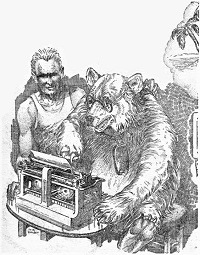
"The Command" is a science fiction story by American writer L. Sprague de Camp. An early treatment of the concept of uplift, it was the first in his Johnny Black series. It was first published in the magazine Astounding Science-Fiction for October, 1938, and first appeared in book form in the hardcover anthology Modern Masterpieces of Science Fiction. It later appeared in the paperback anthology Doorway Into Time and the subsequent de Camp collection The Best of L. Sprague de Camp. The story has also been translated into German.

The Green Magician is a fantasy novella by American writers L. Sprague de Camp and Fletcher Pratt. The fifth story in their Harold Shea series, it was first published in the November 1954 issue of the fantasy pulp magazine Beyond Fiction. It first appeared in book form, together with "The Wall of Serpents", in the collection Wall of Serpents, issued in hardcover by Avalon Books in 1960; the book has been reissued by a number of other publishers since. It has also been reprinted in various magazines, anthologies and collections, including The Dragon, The Complete Compleat Enchanter (1989), Masterpieces of Fantasy and Enchantment (1988), and The Mathematics of Magic: The Enchanter Stories of L. Sprague de Camp and Fletcher Pratt (2007). It has been translated into Italian and German.
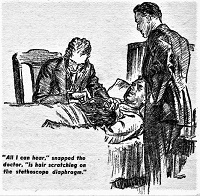
"Hyperpilosity" is a classic science fiction story by L. Sprague de Camp. It was first published in the magazine Astounding Stories for April, 1938, and first appeared in book form in the de Camp collection The Wheels of If and Other Science Fiction (Shasta, 1949; It later appeared in the anthologies Omnibus of Science Fiction, Science Fiction of the Thirties, The Edward De Bono Science Fiction Collection, and The Road to Science Fiction #2: From Wells to Heinlein, as well as the magazine Fantastic Story Magazine and the de Camp collection The Best of L. Sprague de Camp. In 2014 the story was shortlisted for the Retro Hugo Award for Best Short Story.

"The Merman" is a science fiction story by American writer L. Sprague de Camp, based on the concept of human biological engineering. It was first published in the magazine Astounding Science-Fiction for December, 1938. It first appeared in book form in the collection The Wheels of If and Other Science Fiction ; it later appeared in the anthology Science Fiction of the Thirties and the collection The Best of L. Sprague de Camp. The story has been translated into German




